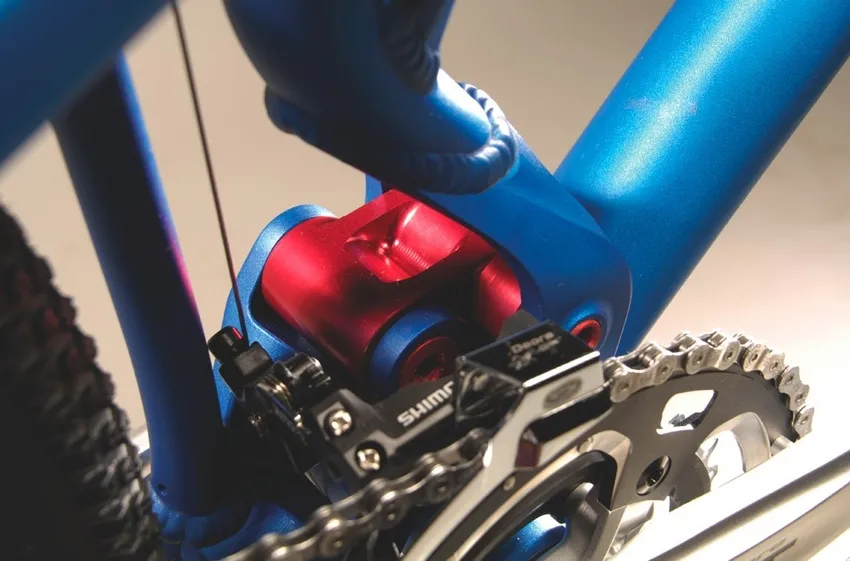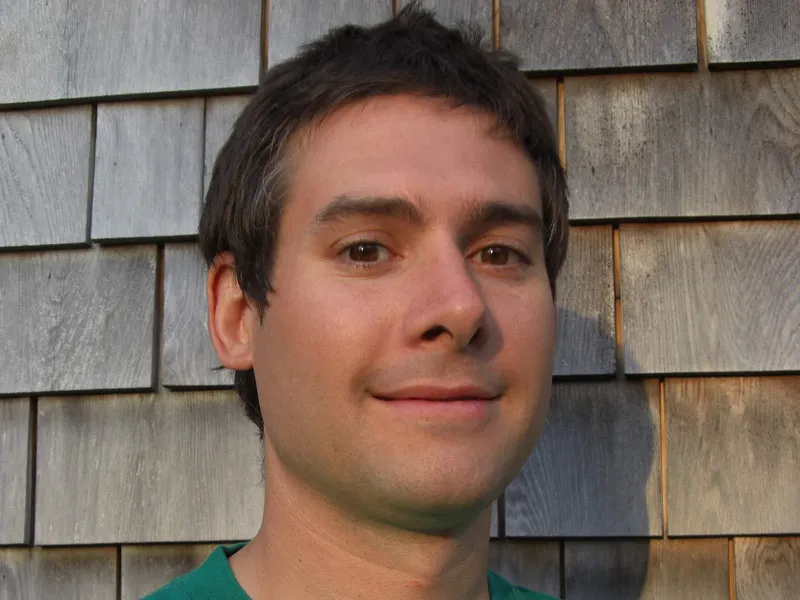Dave Weagle is fast becoming one of the most important designers in the mountain bike world. A mechanical engineer by trade, he entered the world of mountain bike component design after tiring of developing robotic vehicle systems for the US Army’s Special Forces. He was quick to use his knowledge to develop one of the most lauded bicycle suspension systems on the planet, the dw-link.
It has been used to world-beating effect on Sam Hill’s Downhill racing bikes as well as on multi award-winning trail bikes like the Ibis Mojo. In addition, his e.thirteen bashguards are fitted to many of the top downhill and 4 x riders’ bikes.
He’s also been working for a while on a new suspension system called Split Pivot, to be launched by differing manufacturers in the coming year. He talks to Bikeradar’s Marcus Farley about his background, his work methods and his projects to date.
BikeRadar: What’s your background and how did you get started in the bike industry?
DW: As a child I was into sports, building things, and racing. Just like Ricky Bobby I loved to go fast. As I got older I knew that I wanted to be a mechanical engineer and specifically I wanted to eventually be an F1 lead designer.
I worked hard toward that goal in college, but when it came time to move to the UK and follow that dream I had a girlfriend and a life in Boston that I wasn’t ready to leave. I had friends who worked in a government contracted R&D lab, they put in a good word for me, and I got a job in that field, where I eventually became a specialist in developing tactical robotic vehicle systems for special forces operatives. I had always been into bikes when I was in school but could never afford a good one.
While I was working in the R&D field I was making good money, so I bought my first mountain bike so that I could ride with my friends after work. I got into racing dual slalom and then downhill. I quickly found myself dissecting my bike, trying to improve things that I was unhappy with, and eventually built some things that piqued the interest of some fellow riders. I started a company called Evil Bikes to build a chainguide that I designed.
This guide was special, the precursor to the now famous e.thirteen SRS, with the idea being that each part on the guide was designed to have a specific purpose, and to work with all the other parts of the guide in harmony. I coined the term “chain retention system” to describe the product. It used a design that was open at the back to clear mud easily, and a clear polycarbonate bashguard that was light and could absorb impact.
At that point in time all other chainguides used two aluminum plates, either moving or stationary, and those plates would bend easily and get jammed up with mud and debris, eventually failing (typically at the worst time possible, hah). The Evil Security chain retention system was a hit with riders, much more so than we expected. We improved the design with a lot of feedback from riders and launched a new company to sell it called e.thirteen in 2002 using all of my savings to build prototypes and get an Interbike booth.
Through racing, I met a guy named Todd Seplavy who worked for a small east coast company called Iron Horse. I was always helping the local guys tune their suspension, and Todd asked me if I had any suspension ideas that Iron Horse might be able to use. I told him that I had actually been writing patents for something that I thought was going to be really revolutionary, that I was hoping to use to build Evil Bikes full suspension rigs.
I explained to him that it was going to take a lot of time and money to patent the system. Iron Horse stepped up and made me an offer that would give me the funds to patent the system in return for me developing a line of full suspension bikes for them. We struck a deal and dw-link started its path. With that, I was able to leave my military job and concentrate on bikes full time. I haven’t stopped for air since then!
BR: We understand that you’ve just sold Evil Bikes. What influenced you to sell, and is the company in capable hands?
DW: Really, I’ve known that I wouldn’t make the decision to expand Evil Bikes since we started e.thirteen. I know it seems crazy, but frames can be a tough game to be involved in. With Evil, I wanted to make every product a sterling example of the technology available in cycling. To do that takes an immense amount of development time and even more time to verify that each part, prototype to production meets specification.
The Imperial hardtail frame’s development and optimisation process was over 1000 hours. That’s ridiculous! I knew that in 2000/2001 I didn’t have the time or staff to make Evil happen the way that I envisioned it. We concentrated on e.thirteen, and I got my frame and suspension development fix working with guys like Independent Fab, Iron Horse, and Ibis. Evil is in great hands.
The people involved have a lot of years of working in the cycling industry and have had some great successes. It will be awesome to sit back and watch the company bring its unique flavour of goodness to the riders of the world.
BR: So, what’s with the names E.13? and Evil? Are you playing with our superstitions, or just having a joke?
DW: Hah! Actually, we knew the name ‘Evil’ could cause us some PR/ media issues when we started, but we didn’t care. There was no real reason for the name, we were just having some fun with it. E.thirteen, though, actually came from somewhere, but we’ve always kept the origins a family secret. It’s all good stuff though, no real intentions in the names at all.
BR: How much of your design work goes on in your head, and out on the trail, and how much by feeding info into a computer?
DW: For me the two are tied together like peanut butter and jelly (linguistic/culinary note: that’d be a peanut butter and jam sandwich, which tastes better than it sounds…allegedly, ed). You can’t use a computer to help optimize a design that you can’t understand on the trail. It just can’t work out any other way.
For me, everything starts on the trail. Typically I am focusing on a single aspect of performance, whether it’s the feel of different flat pedals, wheel rate and damping feel of suspensions, or anti-squat feel of suspensions, when I am wearing my “test rider” hat, it’s my job to think objectively and carefully about my perceptions so that I can understand them better. From there I break things down to the simplest aspects, then build them back up again on paper and using the computer to isolate certain areas.
The computer can be a great tool, but like the old adage says, garbage in, garbage out. Designers can’t just expect that the computer is going to do the work for them. All that the computer can do is speed up the process, as a designer I need to do the work and supply the creativity.
For suspension systems, I’ve written some very complex programs that I use to help me optimize linkage layouts more efficiently. What used to take me a month in 2001 I can accomplish in one day, today. It’s still up to me to input and interpret data, but it’s my job to work hard to understand that better than anyone else so that I can build the best product possible.
I have yet to make a wheel rate, leverage rate, or anti-squat curve adjustment to a prototype suspension design since I redesigned the first Sunday prototype. Each new design has met my expectations and the expectations of my suspension licensees the first time out. That statistic amazes even me, but I think that it’s a testament to the process really. Of course, you need to prove product out on the trail to make the determination of whether a bike meets its expectations, and the biggest part of testing is getting damper tunes dialed in.
For this, there is little that we can do on the computer beyond the initial design. We know basically where we will be at, but I can’t tell you exactly how many clicks on the rebound a certain shock will need to be at without testing. I can however, tell you within a tenth of a pound how much spring force, damper force output (for a given damper and settings at given shaft speeds), and anti-squat force will be output at the wheel for a given situation before a bike is ever built.
For components, with everything I work on, the emphasis is on strength-to-weight ratio rather than brute strength or pure light weight. Anyone can make something ridiculously strong by adding material, or ridiculously light by taking material away. To do both at the same time takes a good deal of inspiration and in my case some high-powered computing, followed up by exhaustive testing.
BR: Your dw-link garners much admiration as a suspension system. Can you tell us how you came up with the idea and the physics behind it?
DW: I guess I came up with dw-link through the same way that I come up with most of my ideas. When I get involved in something, I like to do it all the way, give 110% effort. I started riding mountain bikes with my friends and soon after I was neck-deep in suspension analysis. I had a background in four-wheeled vehicle suspension dynamics, so I had a little head start.
In 1999 there was very little accurate text available on the analysis of chain driven wheel suspensions. I had to figure out the details myself. Surprisingly, the analysis method that I pieced together back then stands as the first published text ever on the analysis of linkage axle path suspension systems for chain driven wheels. It’s crazy to think that motorcycles went over 100 years without someone piecing it together.
Most of my analysis kept coming back to understanding the dynamics behind what riders termed “suspension bob.” I realized that “bob” was nothing more than the suspension’s combined reaction to mass transfer during acceleration, plus the unbalanced forces of the rider’s legs moving up and down when pedaling. From there, the realization that anti-squat could counteract those forces was a pretty logical step, and dw-link was born.
Through data acquisition testing I proved that mass transfer and the rider’s leg movement had different levels of compression effect on the suspension and at different points in the travel. After a good deal more analysis I ended up with a position sensitive anti-squat curve that could counteract those compressing forces very accurately at different points in the travel. This was the easy part.
After I got to this point, I spent the better part of a year working to develop linkage layouts that would let me design the braking reactions that I wanted, and give the wide range of specific leverage rates that I needed, all in a package that is structurally efficient.

The dw-link on a Pivot bike
Bikeradar: The dw-link is being used by three different manufacturers, Iron Horse, Ibis and Pivot. How does the application and your involvement differ on each manufacturer’s bikes?
DW: I am responsible for all of the suspension kinematics, suspension engineering, and tuning for all of my licensees suspension bikes. Once I complete suspension development, it’s up to them to create the mechanical structure around the kinematics.
The process starts with a signed licensing contract. Once I have a licensing contract in place with a new licensee, the first thing that I like to do is ride their existing bikes. I spend a little time to dial in damper tunes for their bike, to get their design to perform as well as it can. That way we have a common frame of reference to discuss performance later on in the process.
Different people have different preferences for the feel of their bikes, and the same goes for different companies. I like to emphasize this difference in feel, I try to really key in on this so that I can help to give each licensee a suspension that has the “feel” that they want.
Anti-squat performance is nearly identical for all dw-link bikes, for Split Pivot bikes I let that wander a little more. I then discuss braking squat and seat-of-the-pants suspension feel with the licensees. We talk about different bikes that we have ridden, what we liked about one, disliked about another, from there I can piece together the mechanical equivalent of what their “ideal” suspension feel is. This lets me create a linkage layout that achieves that desired suspension feel during acceleration, braking, and through the bumps on and off the power.
A big part of this process is choosing a shock to work with, so each bike is designed around a specific damper and air spring. By knowing the exact air spring curve and damping force outputs at different speeds, I can optimize leverage rates to give the wheel rate that correlates with that “ideal” feel that I mentioned before. I work closely with FOX, Rock Shox, and Answer to gather shock testing data that I use to develop suspensions.
BR: You have a new suspension system called Split Pivot? What is it and is it a replacement for the dw-link?
DW: Split Pivot is my concentric dropout pivot linkage suspension system. The Split Pivot is not intended as replacement for or competitor to my dw-link system, but it is a lower manufacturing cost method of achieving suspension reactions superior to a single pivot bike.
Split Pivot separates acceleration forces from braking forces in the suspension. The system reduces excess suspension compression due to acceleration forces, and at the same time reduces excess compression due to braking forces. Braking neutrality can be tuned independently of acceleration characteristics, and leverage rate curves can be tuned to meet the needs of the application. Shock layout can be vertical, horizontal, floating, or even driven by a modifier link. The system lends itself to ease of manufacture, and can be engineered to build lightweight frame structures without resorting to exotic materials or tube shapes. It can be designed to use 12mm thru axle, Quick Release 12mm axle, or 10mm vertical QR possibilities. Plenty of stock wheels fit the design.
I’ve licensed the system to manufacturers worldwide, you can expect to see it on bikes in the near future. One large company (who Dave is not prepared to name, ed) is marketing the heck out of and selling their own unlicensed version of the Split Pivot, but so far Split Pivot Inc. is the only company with a patent portfolio that protects concentric dropout pivot designs. Readers can check out more about Split Pivot at the www.split-pivot.com website, and the Split Pivot concentric dropout pivot patent applications can be read by following the links below:

